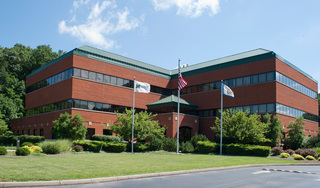 | Back to e-WV
| Back to e-WV
 The West Virginia Encyclopedia
The West Virginia Encyclopedia
 | Back to e-WV
| Back to e-WV
 The West Virginia Encyclopedia
The West Virginia Encyclopedia

Marshall University Graduate College originated in the late 1950s as the Kanawha Valley Graduate Center of West Virginia University. Before that, the Kanawha Valley had had no institution offering advanced degrees. In 1958, the need for local graduate education was articulated by officials at Union Carbide Corporation and other Kanawha Valley chemical concerns. Representatives from these industries formed the Kanawha Valley Graduate Center Committee to establish a graduate center in the Charleston area.
Initially, WVU provided a small number of graduate courses, paid for by student tuition and company subsidies. The cost was high, and the offerings were limited to chemistry and engineering subjects. It was soon obvious that the Kanawha Valley needed a graduate institution of broader scope.
During the 1967 legislative session, $350,000 was appropriated to the center, and tuition was lowered to a reasonable rate. From seven or eight courses in 1958, the center could now offer 35 courses. The new courses included business as well as education and behavioral studies. Enrollment figures soared from 67 students in 1958 to 461 in 1967.
In 1972, the Board of Regents suggested that legislation be enacted to create a new, independent graduate college designed primarily to serve part-time, commuting students. The new college would have its own administrative offices but use the classroom facilities of other institutions, and attune its schedule to the needs of working students. The legislature approved the Board of Regents recommendation, and the West Virginia College of Graduate Studies emerged on July 1, 1972. Enrollment for the fall semester was 1,499. COGS, as it was known, served a large territory including all of southern West Virginia except those counties traditionally served by Marshall University. Circuit-riding professors taught evening classes in 16 counties, most often in high school classrooms.
In 1989, as part of a restructuring of the governance system of higher education, the college officially became the University of West Virginia College of Graduate Studies. In part because of an in-depth study of the state’s higher education system by the Carnegie Foundation, legislation was passed creating dual systems. The college joined the university system which also included WVU, Marshall University, the West Virginia School of Osteopathic Medicine, Potomac State College, and WVU’s community college at Parkersburg. The Carnegie Report praised the College of Graduate Studies for its efforts to deliver graduate education to remote areas and recommended that COGS offer courses wherever needed, regardless of location. Thereafter, the college became a statewide institution.
After the retirement of long-time president James Rowley in December 1991, Dennis P. Prisk became the fourth president of the college. On July 1, 1992, the name was changed to the West Virginia Graduate College. The administrative offices, which had been located on the campus of West Virginia State College since 1980, moved to a new $4 million building in South Charleston. A second structure was added in 1997. The handsome two-story building features advanced technology and 12 additional classrooms.
In 1997, the West Virginia Graduate College became Marshall University College of Graduate Studies. About half of the classes are taught at the South Charleston campus, with the rest taught at other locations or by Internet and distance learning technology.
Written by Kathleen M. Jacobs
Jacobs, Kathleen M. History of the Graduate College. West Virginia Graduate College: Celebrating 25 Years of Service to West Virginia. 1995.